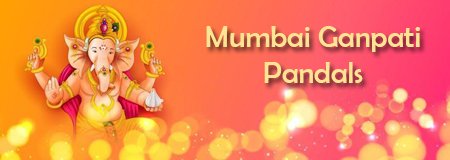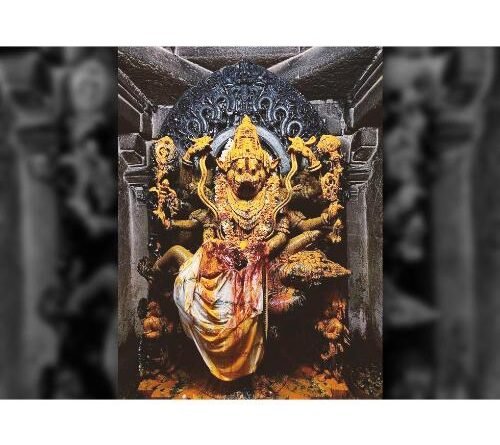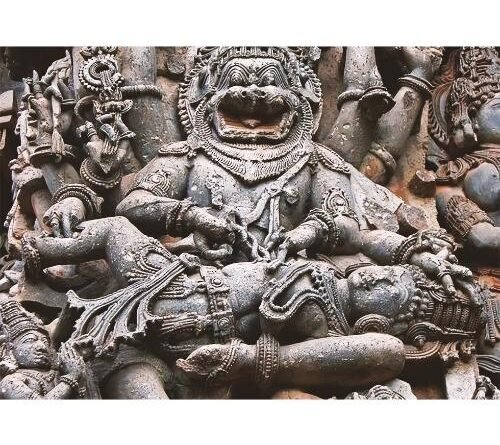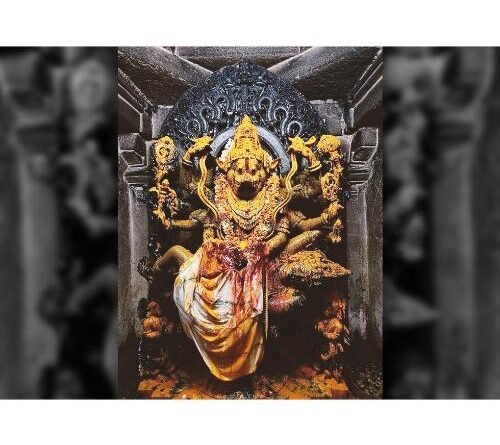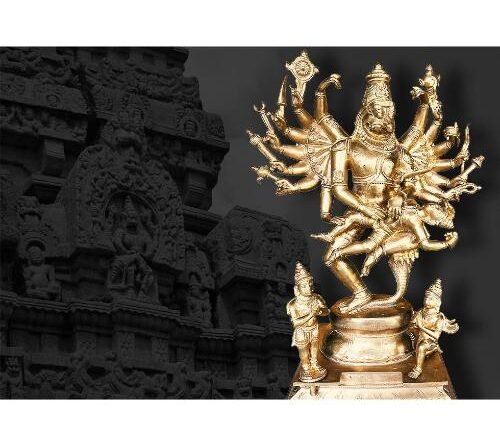Shri Ugra Narasimha Temple, Madduru
Idhu Maddur Ugra Narasimha with Shodashabahu
This idol was blessed by Bramha himself to Arjuna on the order of Sri Krishna Paramatma after Arjuna made severe penance to see the Ugra Narasimha form.
Arjuna wanted to see the Ugra Narasimha form in real but Sri Krishna refused as he can’t take the completed avatara and particularly if Narasimha avatar comes again no one can pacify the lord so Krishna instructed Arjuna to perform penance on Bramhan and Bramha gave this idol to Arjuna. The old name of Maddur town was Arjunapuri. It is in between Chennapatna and Mandya
The beauty of this form of God is you can see all the 16 hands with weapons clearly and the intestine is carved in stone like a live organ. That shows this idol was bramha kararchita and not any manava kararchita. Blessed to see the Lord again in a way
In the history of Hindu scriptures, very few deities evoke fear and terror with such intensity as the fierce lion-man incarnation of Lord Vishnu, the fiery Narasimha. His image, imprinted in the minds of devotees for centuries, goes beyond mere aesthetics, serving as a powerful symbol of cosmic balance, righteous anger and the ultimate protector of dharma. But looking beyond the surface, we find that their form and iconography weave a complex web of symbols, waiting to be unraveled.
a form born of anger
The fiery Narasimha emerging from the pillar to defeat the demon king Hiranyakashipu symbolizes righteous anger at its peak. His half lion, half human form is a powerful symbol of power beyond normal human understanding. The lion’s head symbolizes raw power, untamed and primitive, while the human torso represents their connection to the cosmic order. He stands tall, radiating fearsomeness and a majestic aura, his claws ready to attack and his eyes burning with divine anger.
Statue of Ugra Narasimha
The iconic image of the fierce Narasimha, the half-man, half-lion incarnation of Lord Vishnu, has attracted devotees for centuries. This powerful depiction goes beyond mere aesthetics, becoming a powerful symbol of divine power, righteous anger, and the delicate balance between destruction and creation.
visual description
Central figure: The imposing form of Narasimha dominates the composition. His lion head, adorned with a flaming mane, bears sharp fangs, expressing ferocity and divine wrath. His muscular human body further reflects his immense power.
Sixteen hands: Each hand holds a specific weapon or object, indicating Narasimha’s versatile role. The two hands cleave the demon king Hiranyakashipu, symbolizing the destruction of evil. Two others hold Hiranyakashyap’s intestines, forming a terrible garland that underlines the victory of good over evil. The remaining hands hold the iconic Vishnu weapons: Sudarshana (chakra), Panchajanya (conch), Pasha (gallows), and Ankush (elephant’s goad), which represent divine authority and cosmic order.
Side figures: Prahlad, the devout son of Hiranyakashipu, stands to the right of Narasimha, his unwavering devotion in contrast to the fallen demon king. Garuda, the faithful vehicle of Lord Vishnu, is seen on the left, offering humble prayers with reverence.
Composition and Symbolism: The standing posture of Narasimha over Hiranyakashipu reinforces the narrative of victory over evil. The theme of devotion and protection is subtly highlighted by the inclusion of Prahlad and Garuda.
Explanation
Righteous Anger: The fearsome face of Narasimha reflects the concept of righteous anger, which is an essential force against unjust powers. His actions demonstrate the consequences of disregarding dharma (righteousness).
Balance of power: Despite the violence, Narasimha’s multiple hands hold divine weapons and Prahlad’s presence emphasizes the restoration of cosmic order and the ultimate victory of good over evil.
Inner Strength: Narasimha serves as a powerful symbol, urging devotees to use their inner strength to fight for what is right and protect the innocent. Their roar echoes through time, reminding us of the potential for positive change when guided by righteousness.
Historical and cultural context
The iconography of Ugra Narasimha has evolved over the centuries, reflecting changes in cultural and religious understanding. His portrayal varies across regions and traditions, with some emphasizing his cruelty, while others depicting his compassion. Despite these variations, the core message of righteous anger and cosmic balance remains constant.
Importance
Ugra Narasimha is beyond mere visual depiction. They serve as a powerful symbol, reminding us of the importance of righteous action, the delicate balance between power and compassion, and the potential for positive change within each individual. Their roar continues to echo, urging us to stand up for what is right and embrace our inner strength in the face of injustice.
Role of Ugra Narasimha in various Hindu texts and traditions
Ugra Narasimha, the fearsome half lion, half human incarnation of Lord Vishnu, plays an important role in various Hindu texts and traditions. Although their main messages are righteous anger and stable cosmic order, their interpretation and significance vary across different regions and ideologies.
mythological origin
The primary story about Ugra Narasimha is found in the Puranas, particularly the Vishnu Purana, the Bhagavata Purana and the Narasimha Purana. These texts tell the story of Hiranyakashipu, a demon king who achieved near-immortality and challenged Vishnu’s authority. When Hiranyakashipu’s son Prahlad opposed his anti-religious statements, Vishnu appeared as Narasimha to defeat the demon king. This act restored dharma and protected the pious Prahlad.
Interpretations and significance
Vaishnavism: In Vaishnavism, Narasimha is considered a fierce protector of devotees and protector of cosmic law. His depiction often emphasizes his divine power and victory over evil. Temples dedicated to him, such as the Ahobilam temple in Andhra Pradesh, depict him in awe-inspiring forms.
Shaktism: Some Shakta traditions associate Narasimha with Shakti, the goddess of divine power. They interpret his cruelty as an expression of the creative and destructive energies of the Force. In Kashmir Shaivism, Narasimha represents the fierce aspect of Shiva, who is the ultimate reality.
Tantric traditions: In Tantric traditions, Narasimha may be visualized as a yantra (mystical diagram) or invoked through mantras (sacred chants). He is seen as a powerful deity who can help seekers overcome inner demons and attain liberation.
Regional variations: In different regions, depictions and interpretations of Narasimha differ. In South India, they are often associated with festivals such as Ugadi, which celebrates the beginning of the new year. In Odisha, he is seen as a guardian deity and his temples are visited by large numbers of devotees.
contemporary relevance
The message of Ugra Narasimha continues to resonate even today in contemporary times. They symbolize the following:
Fighting Injustice: Narasimha’s righteous anger inspires individuals to stand up against oppression and fight for what is right.
Inner Strength: They empower the devotees to use their inner strength and courage to overcome challenges.
Balancing Power: Narasimha reminds us of the importance of balancing power with compassion and using it for the greater good.
Understanding the diverse roles and interpretations of Ugra Narasimha in Hindu texts and traditions provides a deeper understanding of his enduring significance. He is not only a fearsome deity, but a complex symbol who continues to provide guidance and inspiration to devotees in various ways.







